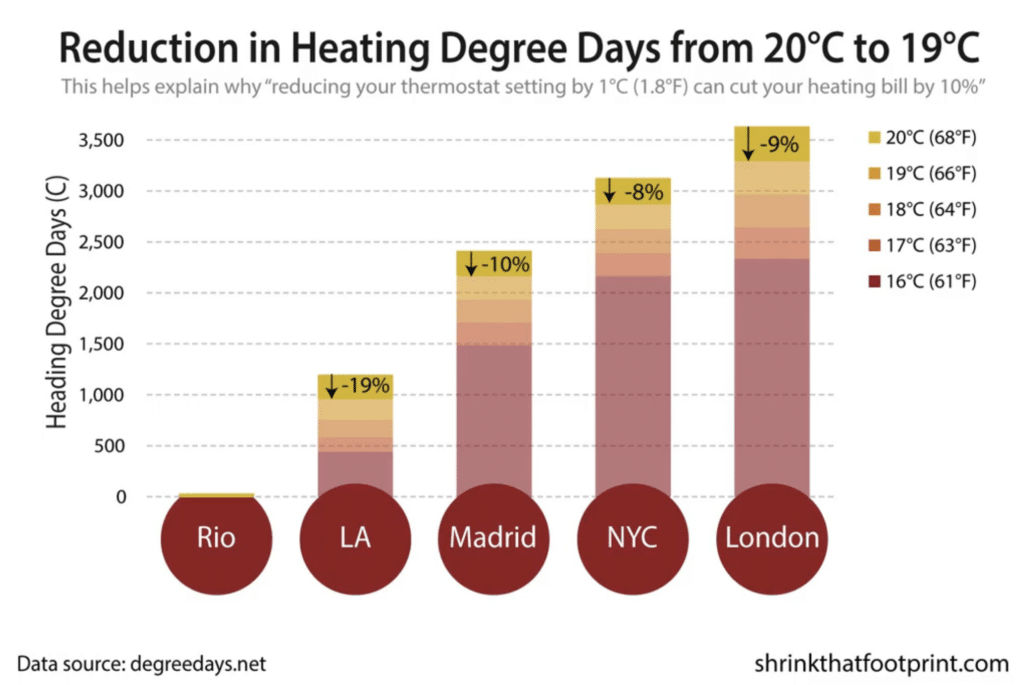Real World Homes Benefit From Energy-Saving Tips To Maximize Heating Dollar
In the ideal world we would all have super insulated homes that meant lovely stable indoor temperature achieved with very limited heating and cooling. If you can get one of those homes through buying, building, renting or refurbishing then great. For the rest of us these three ways to save energy can help us maximize comfort for our heating dollar.

Fundamentals: Know What You’re Paying Now And What You’re Using
Getting the temperature right in your home can make a huge difference to your heating bill. I’m going to talk about how tweaking the temperature in your home can make a big difference to your heating bill. But first off I just want to make sure that you know how much you’re paying for your heat.
If you’re using heating oil or electricity without a heat pump to heat your home then you’re paying a lot per unit of usable heat. We’ve also provided an analysis of heat pump running costs for you to compare to the much worse electricity heating. I know it’s an expensive process switching between heating systems but if you have options to hand it might be worth looking at.
You might also be doing some things like using space heaters that are so inefficient that you can make a big difference by cutting them out. Consider this, we calculated that if you use a space heater rated at 1500W for a month continuous it can add up to $170 per electricity bill depending on what country you live in. Cutting out a space heater would have a sizeable and immediate impact on what you’re paying.
Address Space And Water Heating Separately
Space heating is the process of heating the air within a room or building, while water heating is the process of heating water for use in hot water tanks, showers, and other uses. Space heating is typically accomplished by a furnace or heat pump system, while water heating is typically accomplished by a water heater. Space heating typically requires a larger initial investment than water heating, but may have lower operating costs over time.
Space heating is typically used to improve the comfort of occupants in a building, while water heating is primarily used to supply hot water for various uses. Space heating is typically used in colder climates, while water heating can be used in any climate.
Both space and water heating systems require regular maintenance to ensure optimal performance and to avoid pilot light problems and maintain high efficiency. There are technical solutions that are optimized for one or the other, or both. For example, solar water heaters are specialized to address water heating using solar energy and benefit from federal programs for solar water heater rebates.
One alternative to a permanent store of heated water are the on-demand heated shower head systems. The technology for these seem to be getting better. A past complaint is that they’re not hot enough. A very related technology is the tankless water heater which is located in the traditional place for a water heater, near the furnace, but does not store any water.
Heat Loss Contributes To Increased Energy Demands
I’m going to look at three simple tips you can use to reduce your heating bills. But to understand why they work we need to get to grips with heat loss. The amount of heat your home loses is the main thing determining how much heat you need from your heating system. The total heat loss of your home is a combination of conduction losses through surfaces like walls, floors, and windows, and ventilation losses which is air leaking out of the gaps.
Heat Loss Comes From “Conduction Loss”
More technically, conduction losses are a function of the area, the thermal conductivity of the materials, the temperature difference, and time. For ventilation losses, it is the product of the air change rate, the volume of the space, the temperature difference, and time. If we rearrange this equation a little, we will see that the total heat loss is directly proportional to the temperature difference. From which we can conclude that the total home heat loss is proportional to the difference between internal and external temperatures.

Degree Days
The purpose of this chart is to show the annual number of heating degree days in five different cities. The temperatures are between 16 and 20 degrees centigrade. Rio is very warm and need virtually no heating to maintain warm internal temperatures. LA is still quite warm. Madrid is getting colder. New York is much colder. And then London is even colder again. If we just focus in on the effect of reducing the temperature from 20 to 19 degrees centigrade, we can see that heating degree days are reduced by roughly ten percent.
If we instead reduce the base temperature from 20 down to 16 degrees centigrade or 68 down to 61 degrees Fahrenheit, we see that the reduction in heating degree days is much larger, closer to 40 percent.
This 40 percent is the type of reduction you might see in your heating bill if you are prepared to move from a warmish 20 degree house down to a relatively cold 16 degree house. If at this point you’re expecting me to suggest a correct thermostat setting for your house, you couldn’t be more wrong.
I can’t even agree on the right temperature with my wife, so I’ve got no business telling you how you should heat your home. Instead, what I’m going to do is give you three strategies that maximize the amount of comfort you get for your dollar.
Set Your Standard Temperature Lower And Adjust On The Fly
You can reduce your home’s heat losses and hence its heating bills by lowering the thermostat setting in your home the smart way to do this is to reduce the standard temperature on your thermostat a degree at a time and then on the occasions when you do feel cold just to bump up the heat temporarily.
In our home, we typically set the temperature around 17 or 18 degrees centigrade and then on certain days when you’re quite stagnant or it’s been cold outside you’ll find yourself wanting to bump up the heat which is fine but on other days when you’re busy or it’s slightly warmer you might not feel the cold in which case you’ve use less heat.
Maximize Warming When You Need It
The second strategy is to use your thermostat to time the heating in such a way that maximizes the warmth when you need the heat and allows the house to cool down when you’re not using it. Having it unnecessarily warm when you’re at work or when you’re sleeping just increases your heat losses and hence the amount of heat you need to pump into the home.
In our home, the winter heating typically comes on for an hour in the morning and a few hours in the evening. The key with this strategy is to make sure that your heating is on before you wake up or before you come home, so that the house is nice and warm when you need it. The third strategy is to heat rooms differently depending on their purpose.
Keep Busy Spaces Heated
For a kitchen, living room, or bathroom, you might want to keep the temperature quite warm, around 20 degrees. Whereas in a dining room or study, you could tolerate cooler temperatures, around 17 degrees. And in bedrooms, you can have them even cooler again, if that’s what you like.
I’ll home the living rooms are downstairs, which we hit quite well, but a lot of this heat drifts up, allowing us to heat the upstairs bedrooms and bathrooms minimally. Already showed you like this you need to use a common sense which in our case means we have a very cold bedroom while our kids bedrooms out through all of one year old is actually a lot more month now. Don’t get me wrong, I’m not trying to pretend that each of these three solutions is ideal. They are what they are.
In an ideal world, you have a super insulated home that allows you to keep a very even 20 degrees in all rooms for very little eating costs. But if you’re a renter or can’t afford to improve your insulation, these three tips are a great way to make sure you maximize the amount of comfort you get your eating dollar.
So remember, turn down your thermostat as much as it’s comfortable, time your heating for when you need it most, and heat rooms differently depending on their purpose. Catch us tomorrow for day 17 or we’ll be looking at air conditioning.
Back To Our Shrink Guide: Introducing the Shrink
Lindsay Wilson
I founded Shrink That Footprint in November 2012, after a long period of research. For many years I have calculated, studied and worked with carbon footprints, and Shrink That Footprint is that interest come to life.
I have an Economics degree from UCL, have previously worked as an energy efficiency analyst at BNEF and continue to work as a strategy consultant at Maneas. I have consulted to numerous clients in energy and finance, as well as the World Economic Forum.
When I’m not crunching carbon footprints you’ll often find me helping my two year old son tend to the tomatoes, salad and peppers growing in our upcycled greenhouse.
